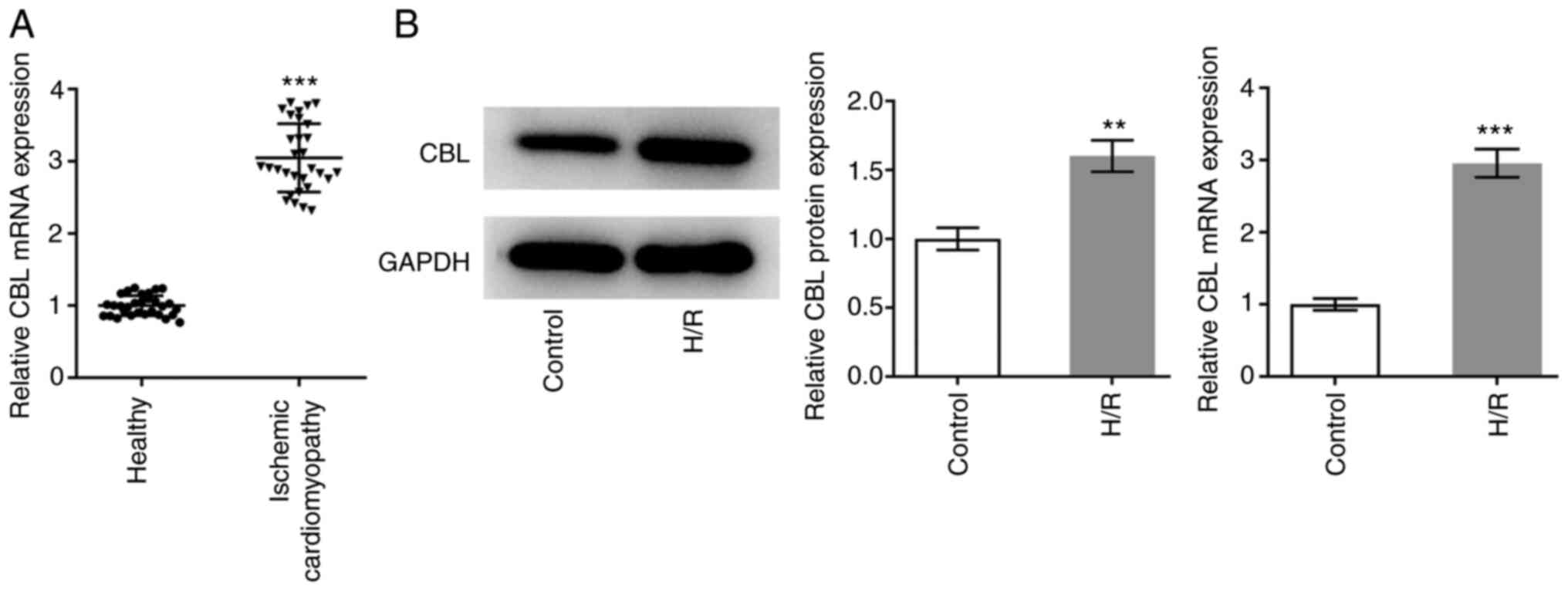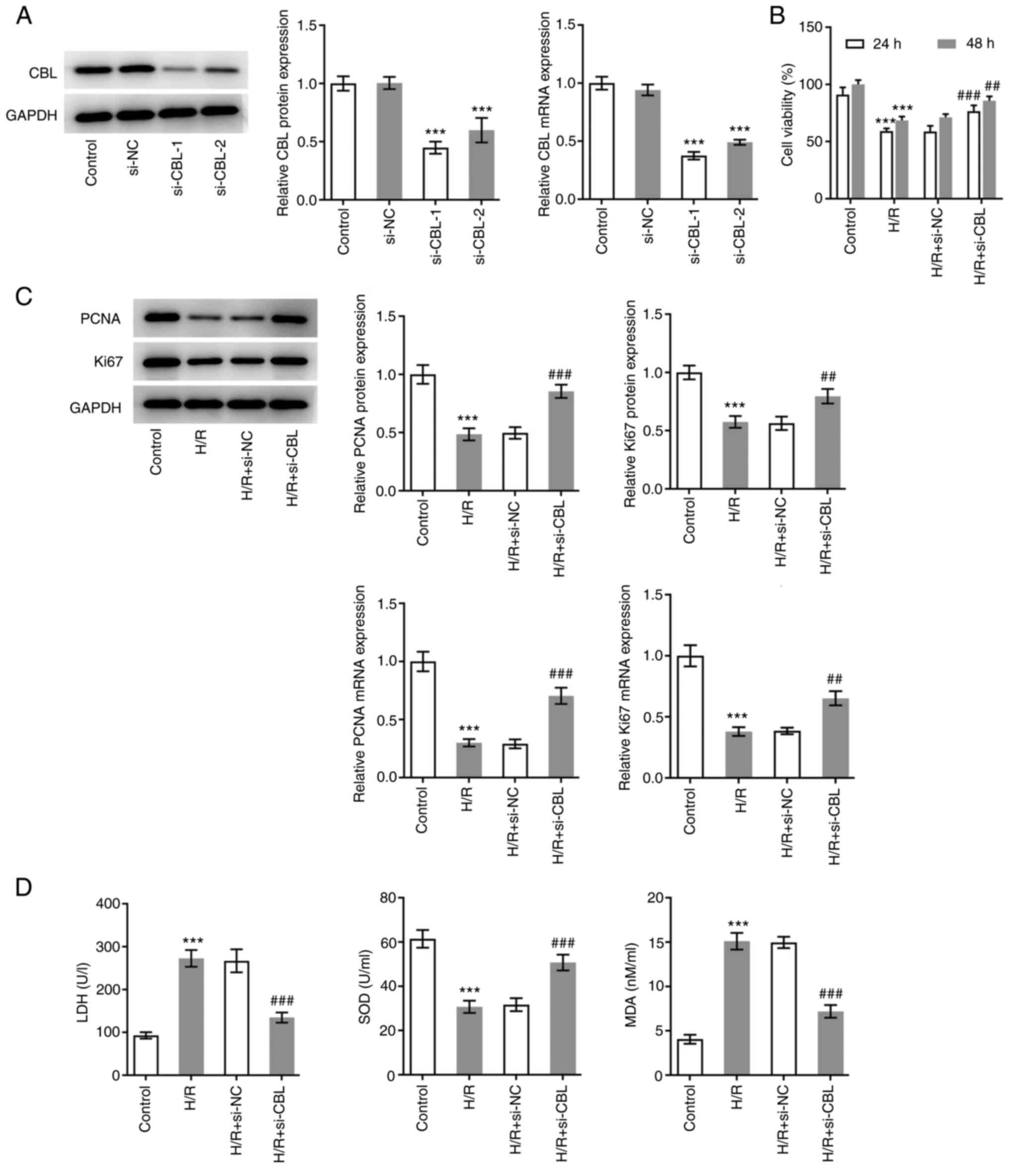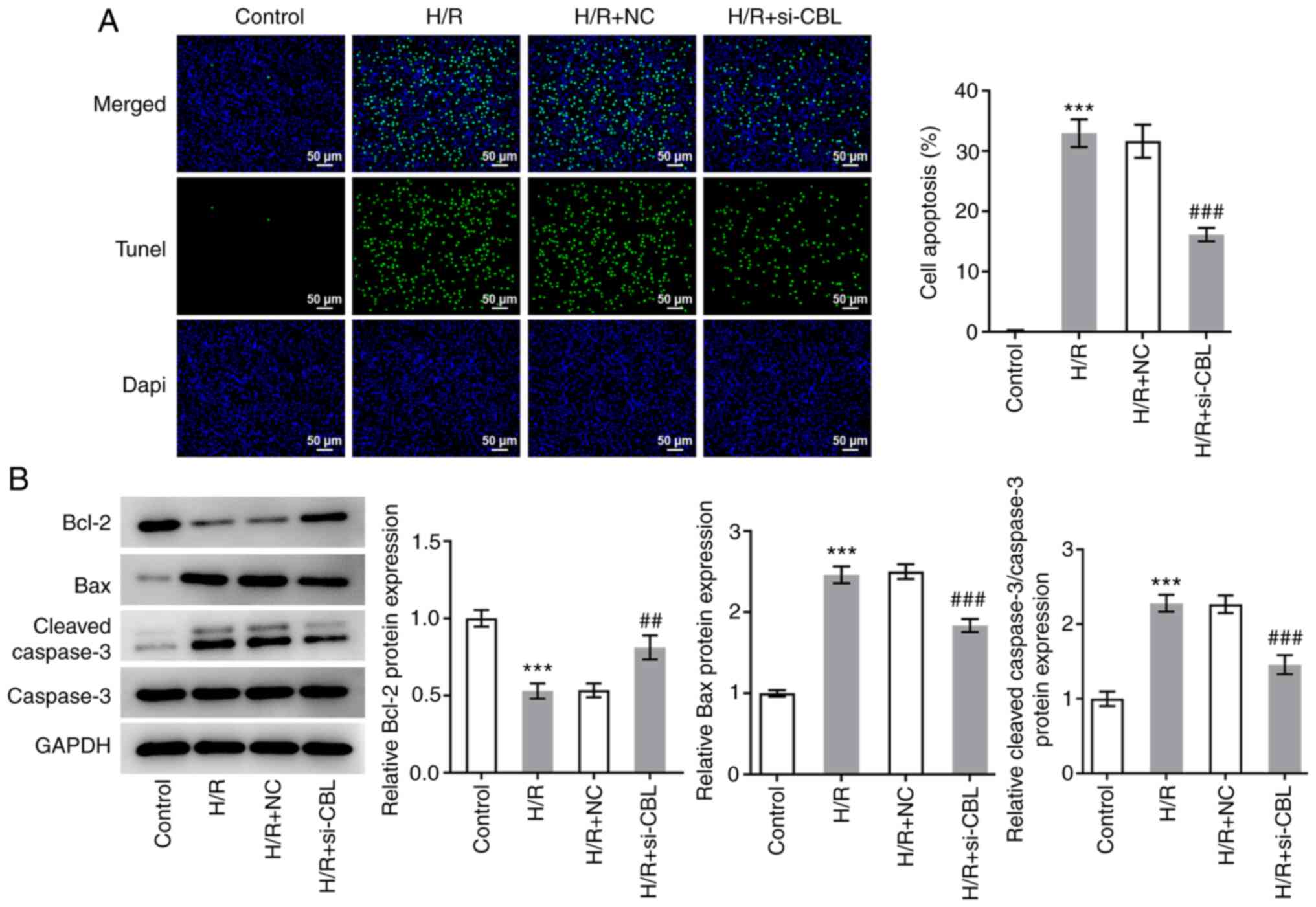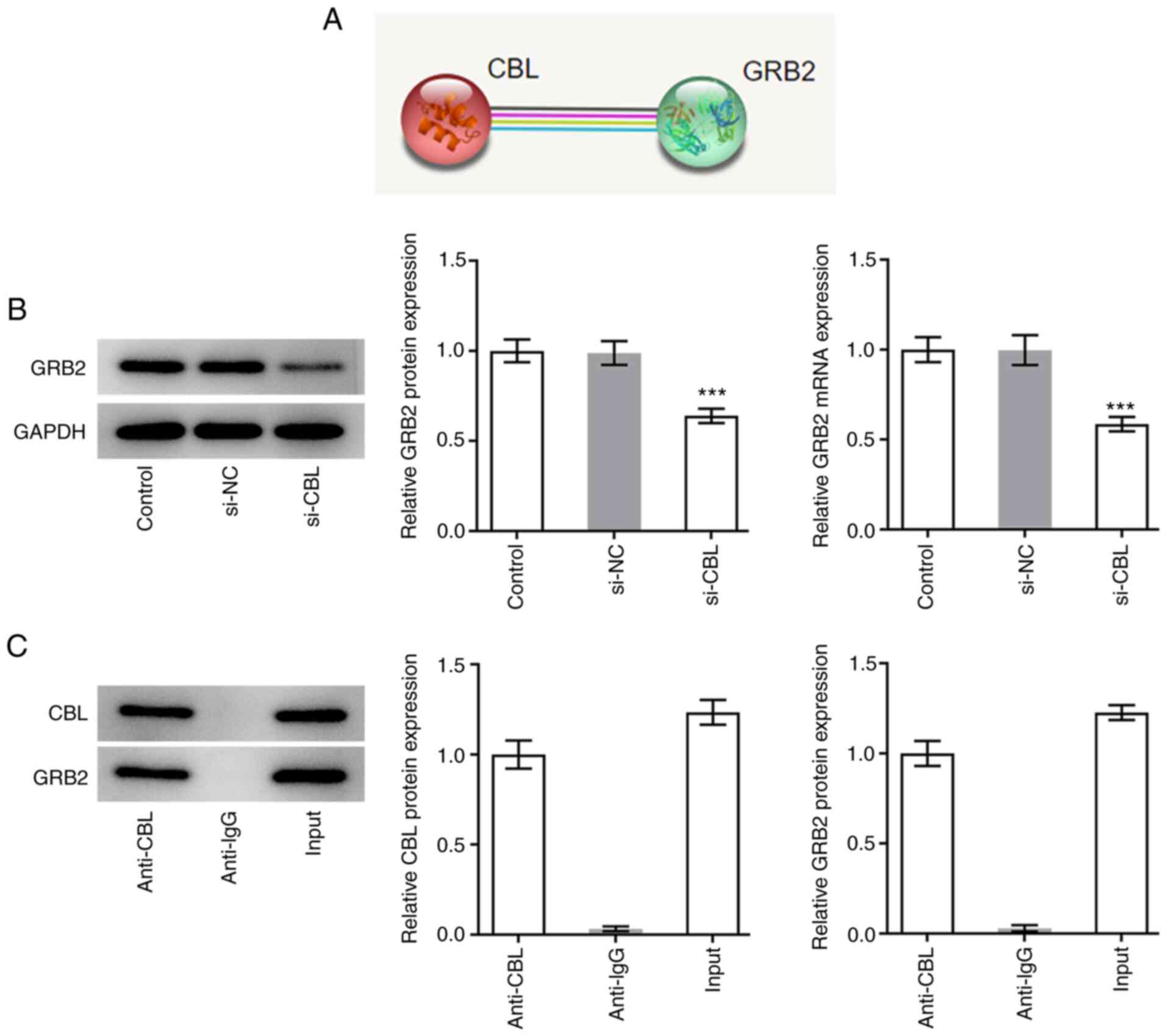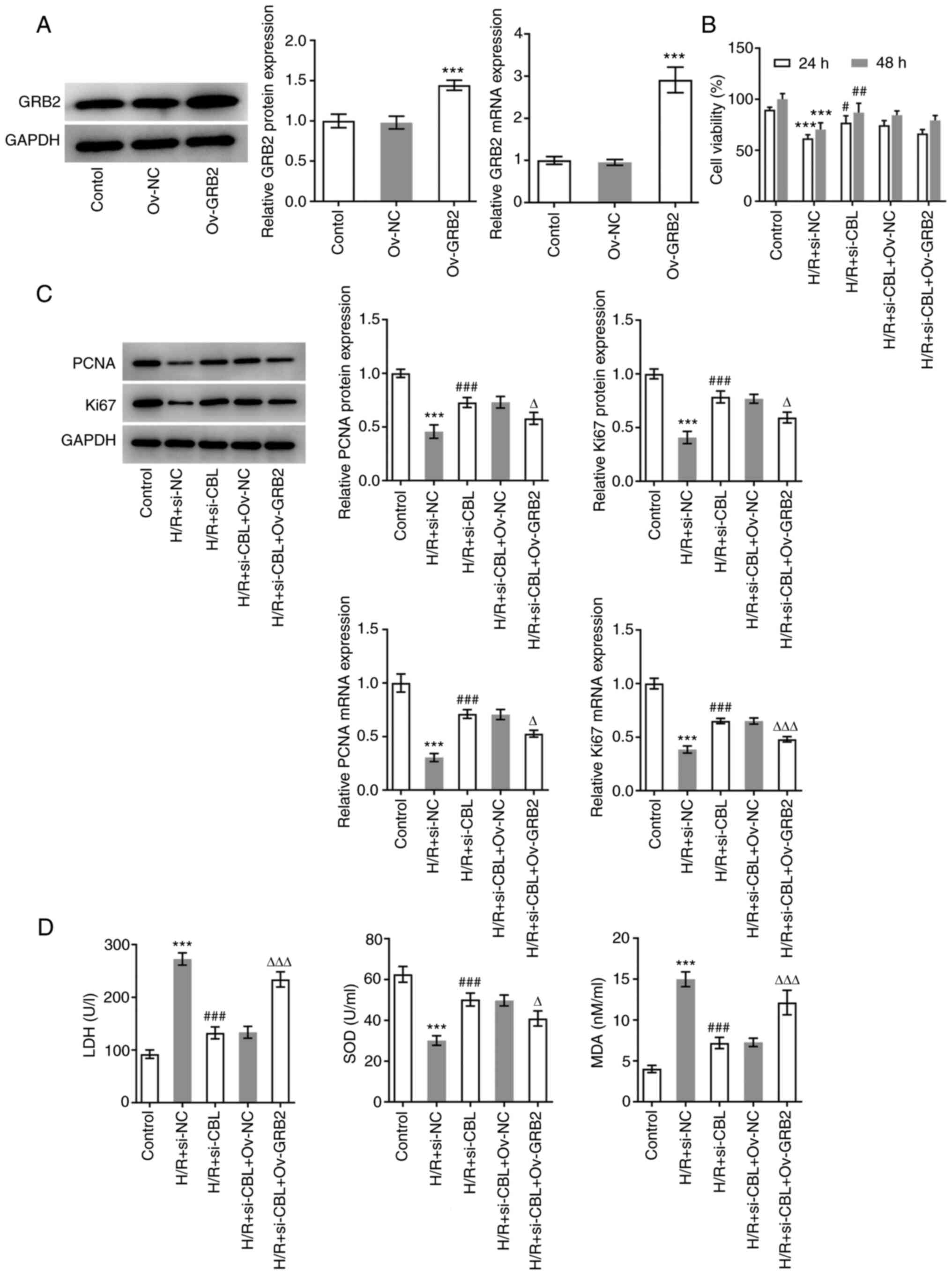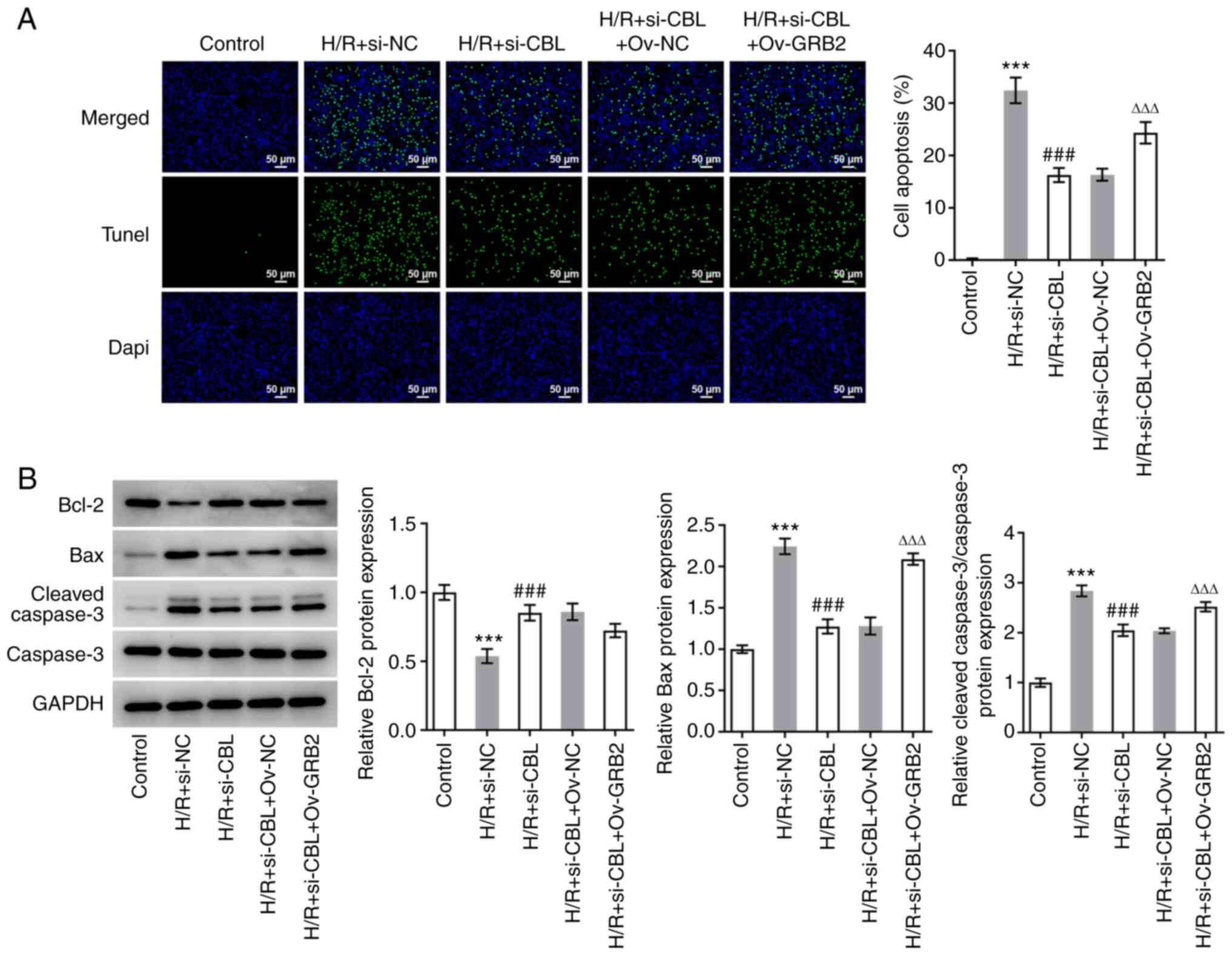CBL knockdown protects cardiomyocytes against hypoxia‑reoxygenation injury by downregulating GRB2 expression
- Authors:
- Published online on: January 3, 2022 https://doi.org/10.3892/etm.2022.11111
- Article Number: 188
-
Copyright: © Lv et al. This is an open access article distributed under the terms of Creative Commons Attribution License.
Abstract
Introduction
Cardiovascular and cerebrovascular diseases are the predominant causes of human death (1). According to the current epidemiological data, it has been revealed that the number of CVD mortalities steadily increased from 12.1 million in 1990 to 18.6 million in 2019 globally (2). Ischemic cardiomyopathy (ICM) is one such type of cardiovascular disease (3). The main cause of myocardial ischemia is coronary artery stenosis, resulting in insufficient blood supply to the myocardium, which hinders aerobic metabolism in myocardial cells and reduces contractile capacity (4,5). Therefore, energy supply during heart activity is rendered insufficient, which can cause arrhythmia and angina pectoris (6). In severe cases, it can result in myocardial infarction (7). For myocardial ischemia, the most effective treatment strategy is currently to quickly restore blood supply to the ischemic section of the heart. However, resuming blood flow after myocardial ischemia for a period of time may lead to myocardial contractile dysfunction and structural damage at the ischemic site, which will aggravate myocardial injury (8). This phenomenon is known as myocardial ischemia-reperfusion injury (MIRI) (8). MIRI is a condition that requires close medical attention and implementation of management following treatment, which mainly consists of coronary artery bypass or cardiopulmonary bypass surgery (9,10). In addition, alleviating MIRI has been hypothesized to be the main cause for successful treatment and prolonged survival in patients (11). Coupled with the continued advancements in surgical techniques, antiplatelet and antithrombotic agents, reperfusion therapy in a timely manner can effectively preserve the patency of coronary arteries (10,12,13). However, the treatment for MIRI has not been effectively improved, evidenced by ~8.8 million mortalities in 2015 worldwide, accounting for 15.5% of all deaths that year (14). Therefore, studying the growth state and metabolic activity of cardiomyocytes is expected to yield significant results for the prevention and treatment strategies for complications caused by MIRI.
Previous studies have shown that the pathogenesis during myocardial ischemia is associated with oxidative stress, chronic inflammation and cardiomyocyte apoptosis (15-17). Reperfusion in the ischemic myocardium results in the production of oxygen free radicals (OFR), which can mediate myocardial damage (18). In addition, production of vast quantities of reactive oxygen species (ROS) during the early stages of reperfusion can lead to dysfunction of the antioxidant system in myocardial cells, causing widespread cell damage and eventually necrosis and apoptosis (19). Therefore, improving the antioxidant capacity of cells may reduce myocardial cell damage caused by MIRI. Cbl proto-oncogene (CBL) is widely expressed in various tissues and contains an N-terminal tyrosine-kinase-binding domain, which can interact with a variety of proteins (20). Elsewhere, Cbl proteins are implicated in the regulation of multiple signal transduction (21). For instance, Cdc42 sequesters Cbl from the epidermal growth-factor receptor (EGFR) through βPIX, thus inhibiting EGFR downregulation (22). In addition, c-Cbl, an adaptor protein, has been reported to participate in the activation of MAP kinases (23). Previous studies have revealed that CBL inhibition can alleviate cardiomyopathy injury. Using c-Cbl as an example, the silencing of c-Cbl helps to improve cardiac function in response to myocardial ischemia (24). Furthermore, CBL-knockout mice exhibit improved abilities to recover heart function following ischemia and reperfusion (24), suggesting that CBL may exert negative regulatory effects on the survival of myocardial cells in addition to angiogenesis following MIRI.
At present, the pathogenesis of MIRI has not been fully elucidated (25). Therefore, it remains in demand to actively explore novel targets and their underlying mechanism of action in MIRI. In the present study, an in vitro MIRI model was constructed through hypoxia-reoxygenation (H/R), where the target of CBL was predicted using bioinformatics analysis. The aim of the present study was to explore the effect of CBL on H/R-induced cardiomyocyte injury and to determine the underlying mechanism.
Materials and methods
Clinical samples
All procedures were performed in accordance with the Declaration of the Institutional Research Committee's Ethical standards and the 1964 Declaration of Helsinki with its later amendments. The Ethics Committee of the Second People's Hospital of Chengdu approved the involvement of human participants and the study ran from August 2017 to August 2019 (approval no. 2017081302). All patients or their parents/guardians provided written informed consent for participation after they were fully informed of the study details.
The plasma samples of 30 patients with ICM (age, 70.2±9.24 years old; 21:9 males and females) and 30 healthy subjects who went to the hospital for health checkups (age, 69±8.12 years old; 21:9 males to females) admitted to The Second People's Hospital of Chengdu (Chengdu, China) between August 2017 and August 2019 were obtained. A total of 5 ml fasting venous blood of the study subjects was drawn into tubes containing vitamin K antagonists and centrifuged at 1,200 x g for 10 min at 4˚C, before the supernatant was collected and stored at -20˚C. According to World Health Organization, ICM presents as a dilated cardiomyopathy with impaired contractile performance (26). The diagnosis of ICM group and all patients in the present study were based on this. MIRI inclusion criteria: Left ventricular ejection fraction still <40% after percutaneous coronary intervention surgery was judged as occurrence of myocardial ischemia-reperfusion injury. MIRI exclusion criteria: Patients have chest pain caused by menopausal syndrome, neurosis, gastroesophageal reflux disease, combined autoimmune diseases, malignant tumors and previous history of cardiovascular and cerebrovascular diseases (27).
Cell culture and treatment
The H9c2 rat cardiomyoblasts were purchased from The Cell Bank of Type Culture Collection of the Chinese Academy of Sciences and cultured in DMEM supplemented with 15% FBS (both Gibco; Thermo Fisher Scientific, Inc.) and 1% penicillin/streptomycin at 37˚C in a humidified incubator with 5% CO2.
To established a cellular MIRI model, serum/glucose-free DMEM was employed. H9c2 cells (1.5x105 cells/well) were placed in an incubator containing 94% N2, 5% CO2 and 1% O2 at 37˚C to simulate hypoxia for 24 h. Subsequently, the cells were placed in an incubator with 5% CO2 at 37˚C and cultured for another 24 and 48 h for reoxygenation at 37˚C. H9c2 cells cultured with 5% CO2 for the full 48 h period were used as the control group. In addition, the group that underwent H/R treatment after 24 h transfection was designated the as H/R + small interfering RNA (si)/or Overexpression (Ov)-group.
Cell transfection
H9c2 cells were seeded into six-well plates at a density of 2x105 cells/well and transfected with 1 µg pcDNA3.1-growth factor receptor-bound protein 2 (GRB2; accession no. NM_030846.2) overexpression vector or pcDNA3.1 empty vector (Hunan Fenghui Biotechnology Co., Ltd.) and/or 50 nM siRNAs against CBL (si-CBL) or negative control (si-NC; Shanghai Genepharma Co., Ltd.) using Lipofectamine® 2000 (Invitrogen; Thermo Fisher Scientific, Inc.) according to the manufacturer's protocol. Following transfection for 24 h, the cells were used for subsequent experiments. si-CBL-1 target, 5'-GGAAGCCATCGCCAAATATGA-3'; si-CBL-2 target, 5'-GTGCTGGAAGCTCATGGACAA-3'; si-NC target, 5'-GGCAGACAATGCGAAACACTT-3'.
Cell Counting Kit 8 (CCK-8) assay
H9c2 cells (1.5x104 cells/well) were cultured in 96-well plates before 10 µl CCK-8 reagent (Beyotime Institute of Biotechnology) was added into each well 24 or 48 h after plating the cells. Cells were then incubated at 37˚C for a further 2 h. The absorbance in each well was measured at a wavelength of 450 nm using a microplate reader (Molecular Devices, LLC).
Reverse transcription-quantitative PCR (RT-qPCR)
Total RNA was extracted from cells using TRIzol® reagent (Invitrogen; Thermo Fisher Scientific, Inc.) and then reverse transcribed into cDNA using Universal RT-PCR kit (cat. no. QN0943; Beijing Baiao Laibo Technology Co., Ltd.) according to the manufacturer's protocols. The mRNA expression levels were measured using SYBR Green Master Mix (cat. no. MT0017; Beijing Baiao Laibo Technology Co., Ltd.) on a StepOnePlus™ Real-time PCR system (Applied Biosystems; Thermo Fisher Scientific, Inc.). The thermocycling conditions were as follows: Initial denaturation at 95˚C for 3 min; followed by 40 cycles of denaturation at 95˚C for 30 sec, annealing at 60˚C for 30 sec and extension at 72˚C for 30 sec. The primer sequences used are listed in Table I. GAPDH was used as internal reference and the relative mRNA expression levels were calculated using the 2-ΔΔCq method (28).
Western blot analysis
Total proteins were extracted from each group of H9c2 cells using RIPA lysis buffer (Beyotime Institute of Biotechnology) and then quantified with bicinchoninic acid protein assay kit (cat. no. P0012S; Beyotime Institute of Biotechnology). Equal amount of proteins (20 µg per lane) were separated by 10% SDS-PAGE and then transferred onto PVDF membranes. Following blocking with 5% non-fat milk for 2 h at room temperature, the membranes were incubated with primary antibodies against CBL (cat. no. ab228785; 1:1,000; Abcam), GRB2 (cat. no. ab32111; 1:1,000; Abcam), Ki67 (cat. no. ab16667; 1:1,000; Abcam), proliferating cell nuclear antigen (PCNA; cat. no. ab18197; 1:1,000; Abcam), Bcl-2 (cat. no. ab32124; 1:1,000; Abcam), Bax (cat. no. ab32503; 1:1,000; Abcam), caspase-3 (cat. no. ab32351; 1:5,000; Abcam) cleaved caspase-3 (cat. no. ab2302; 1:500; Abcam) or GAPDH (cat. no. ab8245; 1:1,000; Abcam) at 4˚C overnight. The membranes were then incubated with HRP-conjugated goat anti-rabbit secondary antibodies (cat. no. ab97080; 1:5,000; Abcam) for 2 h at room temperature. Enhanced chemiluminescence reagent (Thermo Fisher Scientific, Inc.) was used to visualize the protein bands and the gray values were assessed using ImageJ (version 1.8; National Institutes of Health).
Detection of oxidation stress
H9c2 cells were collected and lysed using a cell lysis buffer (cat. no. P0013; Beyotime Institute of Biotechnology), followed by centrifugation at 10,000 x g for 10 min at 4˚C. In total, 200 µl supernatant was collected. Lactate dehydrogenase (LDH; cat. no. A020-2-2), superoxide dismutase (SOD; cat. no. A001-3-2) and malondialdehyde (MDA; cat. no. A003-4-1) detection kits were used according to the manufacturers' protocols (Nanjing Jiancheng Bioengineering Institute). The activity values were calculated based on absorbance using a microplate reader (Thermo Fisher Scientific, Inc.).
TUNEL assay
H9c2 cells (2x104 cells/well) were seeded into a 24-well plate and assay was stained using a TUNEL kit (cat. no. C1086; Beyotime Institute of Biotechnology) according to the manufacturer's protocols. Briefly, cells were first stained by 4% paraformaldehyde for 30 min at room temperature followed by incubation with PBS containing 0.3% Triton X-100 for 5 min at room temperature. TUNEL working fluid was added and cells were incubated for another 1 h at 37˚C away from the light. Subsequently, Antifade Mounting Medium with DAPI (cat. no. P0131; Beyotime Institute of Biotechnology) was employed to treat the cells. A total of 10 randomly selected visual fields were observed using a fluorescence microscope (magnification, x200; Olympus Corporation). Apoptosis rate was calculated as follows: Apoptosis rate %=number of positive apoptotic cells/total number of cells x100%.
Co-immunoprecipitation (co-IP) assay
H9c2 cells were collected and lysed in pre-cooled cell lysis buffer (cat. no. P0013; Beyotime Institute of Biotechnology) containing protease inhibitors at 0˚C. The supernatant was collected after centrifugation at 13,000 x g for 10 min at 4˚C. Subsequently, 0.2 mg protein A agarose beads (cat. no. 20366; Thermo Fisher Scientific, Inc.) that were washed with 100 µl PBS buffer were added to 500 µg lysis buffer and incubated with 2 µg IgG antibody (1:1,000; cat. no. ab172730; Abcam) or CBL antibody (cat. no. 2747; 1:50; Cell Signaling Technology, Inc.) overnight at 4˚C with slow shaking. Following the IP reaction and centrifugation at 1,000 x g at 4˚C for 2 min, the agarose beads were washed with lysis buffer and boiled for 5 min at 100˚C by adding 15 µl 2X SDS sample buffer. This sample were then subjected to western blotting.
Bioinformatics analysis
Search Tool for the Retrieval of Interacting Genes/Proteins (STRING, version 11.0; https://string-db.org/) (29) is an online database used for searching known protein interactions. CBL and GRB2 were first entered together at the multiple-proteins interface and the species Homo sapiens was selected before the result was automatically displayed.
Statistical analysis
Data are presented as the mean ± standard deviation and statistical analysis was performed using GraphPad Prism version 8.0 (GraphPad Software, Inc.). Comparisons among multiple groups were performed using a one-way ANOVA followed by a Tukey's post hoc test and unpaired Student's t test between two groups. All cellular experiments were performed ≥ three times from three different cultures. P<0.05 was considered to indicate a statistically significant difference.
Results
Analysis of CBL expression
The expression levels of CBL in patients with ICM and healthy individuals were measured using RT-qPCR. There were 30 individuals in each group and the expression levels were statistically analyzed. The expression levels of CBL in the plasma of patients with ICM were significantly higher compared with those in the healthy individuals (Fig. 1A). Subsequently, expression levels of CBL in H/R-induced H9c2 cells and normally cultured H9c2 cells were measured using RT-qPCR and western blot analysis. The expression levels in H/R-induced cells were significantly higher compared with those in cells cultured normally (Fig. 1B).
CBL knockdown promotes the proliferation and oxidative stress resistance of H/R-induced H9c2 rat cardiomyoblasts
To explore the specific role of CBL in H/R-induced cells, CBL expression was knocked down by transfection with specific siRNAs before the efficacy of knockdown was assessed using RT-qPCR and western blot analysis. The expression levels of CBL were significantly lower in cells transfected with si-CBL-1 compared with those in cells transfected with si-NC (Fig. 2A). si-CBL-1 was chosen for subsequent experiments due to the higher potency compared with si-CBL-2 (Fig. 2A). The H9c2 cells were subsequently divided into the following four groups: Control group, H/R group, H/R + si-NC group and the H/R + si-CBL group. Viability in each group of cells was first detected using CCK-8 assay. After 24 and 48 h of treatment the results showed that cell viability in the H/R group was significantly lower at both time points compared with that in the control group. In addition, viability in the H/R + si-CBL group was significantly higher compared with that in the H/R + si-NC group, indicating that CBL knockdown alleviated the damage caused by H/R (Fig. 2B). Similarly, PCNA and Ki67 protein expression levels in the cells of each group were detected using western blot analysis and RT-qPCR. Compared with the control group, the expression levels of PCNA and Ki67 were significantly downregulated in H9c2 cells after H/R induction. In addition, their expression levels in the H/R + si-CBL group were significantly higher compared with that in the H/R + si-NC group, suggesting that CBL knockdown also promoted H/R-induced cell proliferation (Fig. 2C). Subsequently, the antioxidant capacity of each group of cells was assessed by specifically measuring LDH, SOD and MDA. From the calculated results, SOD levels were found to be significantly decreased in the H/R group compared with those in the control, but were significantly upregulated in the H/R + si-CBL group compared with those in the H/R + si-NC group (Fig. 2D). By contrast, LDH and MDA levels exhibited an opposite trend (Fig. 2D). This suggests that CBL knockdown improved the antioxidant capacity of H/R-induced cells.
CBL knockdown inhibits H/R-induced myocardial apoptosis
The aforementioned treatment groups were also designated to explore the effects of CBL knockdown on cell apoptosis. The results of the TUNEL assays revealed that the number of apoptotic cells in the H/R group was significantly increased compared with that in the control group (Fig. 3A). In the H/R + si-CBL group, the number of apoptotic cells was significantly lower compared with that in the H/R + si-NC group (Fig. 3A). According to the results of western blot analysis, the expression levels of Bax and cleaved caspase-3 were found to be significantly upregulated in the H/R group compared with those in the control group, whilst knocking down CBL expression significantly reversed this increase in Bax and cleaved caspase-3 expression (Fig. 3B). Additionally, the trend in Bcl-2 expression was found to be opposite to that shown by Bax and cleaved caspase-3 (Fig. 3B). These results suggest that CBL knockdown can inhibit H/R-induced cell apoptosis.
CBL knockdown reduces the expression of GRB2 in H9c2 rat cardiomyoblasts
Notably, GRB2 was revealed to promote the advancement of cardiac fibrosis. Moreover, according to the data on STRING database, GRB2 was predicated to be associated with CBL (Fig. 4A). The expression levels of GRB2 were therefore measured using RT-qPCR and western blot analysis. The expression levels of GRB2 in cells transfected with si-CBL were markedly lower compared with those in the si-NC group (Fig. 4B). The results of co-IP and western blot analysis revealed that both CBL and GRB2 were expressed in the input group and GRB2 protein was revealed to exist in the anti-CBL group. However, IgG could not pull down CBL and was used to rule out false positive results. This suggests that there was an association between these two proteins (Fig. 4C).
CBL knockdown promotes the proliferation and oxidative stress resistance of H/R-induced H9c2 rat cardiomyoblasts by downregulating GRB2 expression
To verify the mechanism by which GRB2 regulate CBL, cells were transfected with pcDNA3.1-GRB2 before transfection efficiency was verified using RT-qPCR and western blotting (Fig. 5A). The expression of GRB2 was markedly enhanced after the cells transfection with GRB2 overexpression plasmids compared with that in the Ov-NC group. The H9c2 cells were then divided into the following five groups: Control group, H/R + si-NC group, H/R + si-CBL group, H/R + si-CBL + Ov-NC group and the H/R + si-CBL + Ov-GRB2 group. The viability of cells in each group was first examined using a CCK-8 assay. As depicted in Fig. 5B, the cell viability in H/R-induced H9c2 cells were significantly increased by CBL-silencing in comparison with that in H/R + si-NC group. Notably, GRB2 overexpression slightly decreased the cell viability in comparison with that in H/R + si-CBL + Ov-NC, revealing that GRB2 overexpression didn't have significant influence on viability of H/R-induced H9c2 cells transfection with siRNA specific CBL. In addition, the expression levels of PCNA and Ki67 were both significantly downregulated in the H/R + si-CBL + Ov-GRB2 group compared with those in the H/R + si-CBL + Ov-NC group (Fig. 5C). LDH, SOD and MDA levels were also assessed. SOD levels were found to be significantly downregulated, whilst LDH and MDA levels were significantly upregulated following GRB2 overexpression, compared with those in the H/R + si-CBL + Ov-NC group (Fig. 5D).
CBL knockdown inhibits H/R-induced myocardial apoptosis by downregulating GRB2 expression
The same five groups of H9c2 cells aforementioned were used to explore the effects of GRB2 and CBL on apoptosis. The levels of apoptosis and the expression levels of apoptosis-related proteins in each group were determined using a TUNEL assay and western blot analysis, respectively. The number of apoptotic cells in the H/R + si-CBL + Ov-GRB2 group was significantly greater compared with that in the H/R + si-CBL + Ov-NC group (Fig. 6A). In addition, compared with H/R + si-NC, CBL-silencing significantly upregulated Bcl-2 expression but significantly downregulated the expression levels of Bax and cleaved caspase-3; while GRB2 overexpression reversed the inhibitory effects of CBL-silencing on apoptosis, evidenced by the downregulated Bcl-2 expression but upregulated expression levels of Bax and cleaved caspase-3 in contrast to that in the H/R + si-CBL + Ov-NC group (Fig. 6B).
Discussion
In previous experimental and clinical studies, a number of treatment strategies for preventing MIRI have been proposed, including ischemic pre-conditioning (IPC), ischemic post-conditioning (IPost), remote ischemic conditioning (RIC) and drug intervention (30). IPC entails multiple transient ischemia-reperfusion treatments in coronary arteries to activate the endogenous protective mechanisms and enhance ischemic tolerance (31). IPost consists of allowing the coronary blood to flow back for a period of time before obstructing it again (32). This reperfusion/obstruction process is repeated several times to complete the reperfusion treatment (32). RIC entails the prevention of MIRI by simultaneously applying ≥ one brief intermittent reperfusion cycles to another organ or tissue (33). In addition, various novel drug targets have been discovered, where examples such as Exenatide and Cyclosporin have demonstrated potential (30). However, to date no effective therapeutic agent exist for the prevention and treatment of reperfusion injury (34). A previous study found that pre-administration of fish oil and flaxseed oil to rats alleviated MIRI through regulation of the mitochondrial membrane permeability transport pore (35). In addition, a number of genes have been considered to be promising targets, such as sirtuin 3(36), melatonin receptor 2(37) and protein inhibitor of activated STAT1(16). Due to the lack of known therapeutic targets approved for clinical use, the present study assessed the effects of CBL on the proliferation, antioxidant capacity and apoptosis of H9c2 rat cardiomyoblasts induced by H/R. The results suggested that CBL may serve to be an effective therapeutic target in the future.
Under normal physiological conditions, OFR increases lipid peroxidation, resulting in the production of MDA and LDH (38,39). OFR can be scavenged by SOD and glutathione, which maintains the balance between the generation and elimination of OFR (40). The oxidative capacity of cardiomyocytes is significantly enhanced during MIRI, where unsaturated fatty acids on the membrane can be attacked to trigger alterations in the cell membrane functional unit structure and function (19). The increased production of OFRs may cause cardiomyocyte necrosis and dysfunction (41). Therefore, the present study explored the effects of CBL on the antioxidant capacity of cardiomyocytes following H/R, which found that CBL knockdown improved the antioxidant capacity of this H9c2 cell model. In addition, associated proteins were predicted using the STRING database, where it was found that GRB2 and CBL may be associated. Additionally, GRB2-silencing was reported to suppress TGF-β1-induced collagen production and cell viability in cardiac fibrosis, revealing that GRB2 participated in the promotion of cardiac fibrosis (42). Therefore, it is proposed that GRB2 may be involved in the role of CBL in cardiomyocytes. Results in the present study revealed that GRB2 was involved in the mechanism of action of CBL.
Apoptosis is the most common type of programmed cell death and has been shown to be the major pathological mechanism underlying MIRI (15). Aberrant levels of apoptosis will aggravate the destruction of the myocardium, resulting in a decrease in the number of viable myocardial cells and thus cardiac function, thereby aggravating myocardial damage (43). Mitochondria are vital for the production of ATP and the induction of cell apoptosis (44). Cytochrome c, a marker of activation of the mitochondrial apoptosis pathway, can activate pro-caspase 9, thereby promoting the activation of caspase-3(45). In addition, Bax is a pro-apoptotic protein (46). Following activation of Bax, it enters the mitochondria from the cytoplasm, increases the permeability of the mitochondrial membrane and promotes the release of cytochrome c, thereby mediating cell apoptosis (47). Bcl-2 is an anti-apoptotic protein, which can inhibit the release of cytochrome c from the mitochondria and inhibit cell apoptosis (48). In the present study, CBL knockdown downregulated the expression of Bax and caspase-3 whilst upregulating the expression of Bcl-2, suggesting that it can alleviate the apoptosis of cardiomyocytes induced by H/R.
In conclusion, the results of the present study revealed that CBL expression was upregulated in the plasma of patients with ICM. CBL knockdown promoted the proliferation and increased the antioxidant capacity of damaged cardiomyocytes induced by H/R whilst inhibiting cell apoptosis, by regulating the expression of GRB2. CBL may thus serve as a target for the management of MIRI. Whilst the underlying mechanism was elucidated to a certain depth, the present article is limited in that only in vitro experiments were performed. Future studies should verify these findings using in vivo models.
Acknowledgements
Not applicable.
Funding
Funding: No funding was received.
Availability of data and materials
The datasets used and/or analyzed during the current study are available from the corresponding author on reasonable request.
Authors' contributions
ZL and XL designed the study. ZL, XL, BH and QY performed the experiments. JL revised the manuscript for important intellectual content. JL and YH collected the clinical data and analyzed the data. All authors have read and approved the final manuscript. JL and YH can confirm the authenticity of the raw data.
Ethics approval and consent to participate
All procedures were performed in accordance with the Declaration of the Institutional Research Committee's Ethical standards, as well as the 1964 Declaration of Helsinki and its later amendments. The Ethics Committee of the Second People's Hospital of Chengdu approved the involvement of human participants, and the study ran from August 2017 to August 2019 (approval no. 2017081302). All the patients or their parents/guardians provided informed consent.
Patient consent for publication
Not applicable.
Competing interests
The authors declare that they have no competing interests.
References
|
Brueck M, Koerholz D, Nuernberger W, Juergens H, Goebel U and Wahn V: Elimination of l-asparaginase in children treated for acute lymphoblastic leukemia. Dev Pharmacol Ther. 12:200–204. 1989.PubMed/NCBI | |
|
Roth GA, Mensah GA, Johnson CO, Addolorato G, Ammirati E, Baddour LM, Barengo NC, Beaton AZ, Benjamin EJ, Benziger CP, et al: Global burden of cardiovascular diseases and risk factors, 1990-2019: Update from the GBD 2019 study. J Am Coll Cardiol. 76:2982–3021. 2020.PubMed/NCBI View Article : Google Scholar | |
|
Dang H, Ye Y, Zhao X and Zeng Y: Identification of candidate genes in ischemic cardiomyopathy by gene expression omnibus database. BMC Cardiovasc Disord. 20(320)2020.PubMed/NCBI View Article : Google Scholar | |
|
Dixon SR, Henriques JP, Mauri L, Sjauw K, Civitello A, Kar B, Loyalka P, Resnic FS, Teirstein P, Makkar R, et al: A prospective feasibility trial investigating the use of the Impella 2.5 system in patients undergoing high-risk percutaneous coronary intervention (The PROTECT I Trial): Initial U.S. experience. JACC Cardiovasc Interv. 2:91–96. 2009.PubMed/NCBI View Article : Google Scholar | |
|
Henriques JP, Remmelink M, Baan J Jr, van der Schaaf RJ, Vis MM, Koch KT, Scholten EW, de Mol BA, Tijssen JG, Piek JJ and de Winter RJ: Safety and feasibility of elective high-risk percutaneous coronary intervention procedures with left ventricular support of the Impella recover LP 2.5. Am J Cardiol. 97:990–992. 2006.PubMed/NCBI View Article : Google Scholar | |
|
Kiyooka T and Satoh Y: Mid-ventricular obstructive hypertrophic cardiomyopathy with an apical aneurysm caused by vasospastic angina. Tokai J Exp Clin Med. 39:29–33. 2014.PubMed/NCBI | |
|
Fanari Z, Abraham N, Hammami S and Qureshi WA: High-risk acute coronary syndrome in a patient with coronary subclavian steal syndrome secondary to critical subclavian artery stenosis. Case Rep Cardiol. 2014(175235)2014.PubMed/NCBI View Article : Google Scholar | |
|
Wang X, Chen J and Huang X: Rosuvastatin attenuates myocardial ischemia-reperfusion injury via upregulating miR-17-3p-mediated autophagy. Cell Reprogram. 21:323–330. 2019.PubMed/NCBI View Article : Google Scholar | |
|
Bulluck H and Hausenloy DJ: Ischaemic conditioning: Are we there yet? Heart. 101:1067–1077. 2015.PubMed/NCBI View Article : Google Scholar | |
|
Hausenloy DJ and Yellon DM: Myocardial ischemia-reperfusion injury: A neglected therapeutic target. J Clin Invest. 123:92–100. 2013.PubMed/NCBI View Article : Google Scholar | |
|
Wu MY, Yiang GT, Liao WT, Tsai AP, Cheng YL, Cheng PW, Li CY and Li CJ: Current mechanistic concepts in ischemia and reperfusion injury. Cell Physiol Biochem. 46:1650–1667. 2018.PubMed/NCBI View Article : Google Scholar | |
|
Ziegler M, Wang X and Peter K: Platelets in cardiac ischaemia/reperfusion injury: A promising therapeutic target. Cardiovasc Res. 115:1178–1188. 2019.PubMed/NCBI View Article : Google Scholar | |
|
Fanari Z, Weiss S and Weintraub WS: Cost effectiveness of antiplatelet and antithrombotic therapy in the setting of acute coronary syndrome: Current perspective and literature review. Am J Cardiovasc Drugs. 15:415–427. 2015.PubMed/NCBI View Article : Google Scholar | |
|
World Health Organization. The top 10 causes of death. Available from: http://www.who.int/mediacentre/factsheets/fs310/en/. WHO website, 2018. | |
|
Huang ZQ, Xu W, Wu JL, Lu X and Chen XM: MicroRNA-374a protects against myocardial ischemia-reperfusion injury in mice by targeting the MAPK6 pathway. Life Sci. 232(116619)2019.PubMed/NCBI View Article : Google Scholar | |
|
Xie B, Liu X, Yang J, Cheng J, Gu J and Xue S: PIAS1 protects against myocardial ischemia-reperfusion injury by stimulating PPARγ SUMOylation. BMC Cell Biol. 19(24)2018.PubMed/NCBI View Article : Google Scholar | |
|
Liang S, Ping Z and Ge J: Coenzyme Q10 regulates antioxidative stress and autophagy in acute myocardial ischemia-reperfusion injury. Oxid Med Cell Longev. 2017(9863181)2017.PubMed/NCBI View Article : Google Scholar | |
|
Chen S, Zhu Q, Ju H, Hao J, Lai Z, Zou C, Zhang W, Zhao S, Chen X, Zhang H, et al: The role of oxygen free radicals in myocardial ischemia/reperfusion injury. Chin Med Sci J. 6:127–131. 1991.PubMed/NCBI | |
|
Tian L, Cao W, Yue R, Yuan Y, Guo X, Qin D, Xing J and Wang X: Pretreatment with Tilianin improves mitochondrial energy metabolism and oxidative stress in rats with myocardial ischemia/reperfusion injury via AMPK/SIRT1/PGC-1 alpha signaling pathway. J Pharmacol Sci. 139:352–360. 2019.PubMed/NCBI View Article : Google Scholar | |
|
Grøvdal LM, Stang E, Sorkin A and Madshus IH: Direct interaction of Cbl with pTyr 1045 of the EGF receptor (EGFR) is required to sort the EGFR to lysosomes for degradation. Exp Cell Res. 300:388–395. 2004.PubMed/NCBI View Article : Google Scholar | |
|
Schmidt MHH and Dikic I: The Cbl interactome and its functions. Nat Rev Mol Cell Biol. 6:907–918. 2005.PubMed/NCBI View Article : Google Scholar | |
|
Wu WJ, Tu S and Cerione RA: Activated Cdc42 sequesters c-Cbl and prevents EGF receptor degradation. Cell. 114:715–725. 2003.PubMed/NCBI View Article : Google Scholar | |
|
Swaminathan G and Tsygankov AY: The Cbl family proteins: Ring leaders in regulation of cell signaling. J Cell Physiol. 209:21–43. 2006.PubMed/NCBI View Article : Google Scholar | |
|
Rafiq K, Kolpakov MA, Seqqat R, Guo J, Guo X, Qi Z, Yu D, Mohapatra B, Zutshi N, An W, et al: c-Cbl inhibition improves cardiac function and survival in response to myocardial ischemia. Circulation. 129:2031–2043. 2014.PubMed/NCBI View Article : Google Scholar | |
|
Yu SY, Dong B, Fang ZF, Hu XQ, Tang L and Zhou SH: Knockdown of lncRNA AK139328 alleviates myocardial ischaemia/reperfusion injury in diabetic mice via modulating miR-204-3p and inhibiting autophagy. J Cell Mol Med. 22:4886–4898. 2018.PubMed/NCBI View Article : Google Scholar | |
|
Richardson P, McKenna W, Bristow M, Maisch B, Mautner B, O'Connell J, Olsen E, Thiene G, Goodwin J, Gyarfas I, et al: Report of the 1995 World Health Organization/international society and federation of cardiology task force on the definition and classification of cardiomyopathies. Circulation. 93:841–842. 1996.PubMed/NCBI View Article : Google Scholar | |
|
Liu D: Effects of Nicorandil combined with Danhong injection on SOD and MDA content in patients with myocardial ischemia-reperfusion injury. Mod J Integr Tradit Chin West Med. 1:78–80. 2016. | |
|
Livak KJ and Schmittgen TD: Analysis of relative gene expression data using real-time quantitative PCR and the 2(-Delta Delta C(T)) method. Methods. 25:402–408. 2001.PubMed/NCBI View Article : Google Scholar | |
|
Szklarczyk D, Gable AL, Nastou KC, Lyon D, Kirsch R, Pyysalo S, Doncheva NT, Legeay M, Fang T, Bork P, et al: The STRING database in 2021: Customizable protein-protein networks, and functional characterization of user-uploaded gene/measurement sets. Nucleic Acids Res. 49:D605–D612. 2021.PubMed/NCBI View Article : Google Scholar | |
|
Hausenloy DJ: Conditioning the heart to prevent myocardial reperfusion injury during PPCI. Eur Heart J Acute Cardiovasc Care. 1:13–32. 2012.PubMed/NCBI View Article : Google Scholar | |
|
Hausenloy DJ, Candilio L, Evans R, Ariti C, Jenkins DP, Kolvekar S, Knight R, Kunst G, Laing C, Nicholas J, et al: Remote ischemic preconditioning and outcomes of cardiac surgery. N Engl J Med. 373:1408–1417. 2015.PubMed/NCBI View Article : Google Scholar | |
|
Miao W, Yan Y, Bao TH, Jia WJ, Yang F, Wang Y, Zhu YH, Yin M and Han JH: Ischemic postconditioning exerts neuroprotective effect through negatively regulating PI3K/Akt2 signaling pathway by microRNA-124. Biomed Pharmacother. 126(109786)2020.PubMed/NCBI View Article : Google Scholar | |
|
Heusch G, Bøtker HE, Przyklenk K, Redington A and Yellon D: Remote ischemic conditioning. J Am Coll Cardiol. 65:177–195. 2015.PubMed/NCBI View Article : Google Scholar | |
|
Soares ROS, Losada DM, Jordani MC, Évora P and Castro-E-Silva O: Ischemia/reperfusion injury revisited: An overview of the latest pharmacological strategies. Int J Mol Sci. 20(5034)2019.PubMed/NCBI View Article : Google Scholar | |
|
Ivary SHA, Jajarmy N, Shahri MK, Shokoohi M, Shoorei H, Ebadi A, Moghimian M and Sigaroodi F: Effect of fish and flaxseed oil supplementation on isoprenaline-induced myocardial infarction in rats: Inhibition of mitochondrial permeability transition pore opening. Crescent J Med Biol Sci. 6:158–163. 2019. | |
|
Zheng Y, Shi B, Ma M, Wu X and Lin X: The novel relationship between Sirt3 and autophagy in myocardial ischemia-reperfusion. J Cell Physiol. 234:5488–5495. 2019.PubMed/NCBI View Article : Google Scholar | |
|
Han D, Wang Y, Chen J, Zhang J, Yu P, Zhang R, Li S, Tao B, Wang Y, Qiu Y, et al: Activation of melatonin receptor 2 but not melatonin receptor 1 mediates melatonin-conferred cardioprotection against myocardial ischemia/reperfusion injury. J Pineal Res. 67(e12571)2019.PubMed/NCBI View Article : Google Scholar | |
|
Li J, Zheng X, Ma X, Xu X, Du Y, Lv Q, Li X, Wu Y, Sun H, Yu L and Zhang Z: Melatonin protects against chromium(VI)-induced cardiac injury via activating the AMPK/Nrf2 pathway. J Inorg Biochem. 197(110698)2019.PubMed/NCBI View Article : Google Scholar | |
|
Yang D, Yang Q, Fu N, Li S, Han B, Liu Y, Tang Y, Guo X, Lv Z and Zhang Z: Hexavalent chromium induced heart dysfunction via Sesn2-mediated impairment of mitochondrial function and energy supply. Chemosphere. 264(128547)2021.PubMed/NCBI View Article : Google Scholar | |
|
Bouayed J and Bohn T: Exogenous antioxidants-double-edged swords in cellular redox state: Health beneficial effects at physiologic doses versus deleterious effects at high doses. Oxid Med Cell Longev. 3:228–237. 2010.PubMed/NCBI View Article : Google Scholar | |
|
Puente BN, Kimura W, Muralidhar SA, Moon J, Amatruda JF, Phelps KL, Grinsfelder D, Rothermel BA, Chen R, Garcia JA, et al: The oxygen-rich postnatal environment induces cardiomyocyte cell-cycle arrest through DNA damage response. Cell. 157:565–579. 2014.PubMed/NCBI View Article : Google Scholar | |
|
Sun F, Zhuang Y, Zhu H, Wu H, Li D, Zhan L, Yang W, Yuan Y, Xie Y, Yang S, et al: LncRNA PCFL promotes cardiac fibrosis via miR-378/GRB2 pathway following myocardial infarction. J Mol Cell Cardiol. 133:188–198. 2019.PubMed/NCBI View Article : Google Scholar | |
|
Peng X, Lin L, Zhou X, Yang D, Cao Y, Yin T and Liu Y: miR-133b inhibits myocardial ischemia-reperfusion-induced cardiomyocyte apoptosis and accumulation of reactive oxygen species in rats by targeting YES1. Nan Fang Yi Ke Da Xue Xue Bao. 40:1390–1398. 2020.PubMed/NCBI View Article : Google Scholar : (In Chinese). | |
|
Su C, Fan X, Xu F, Wang J and Chen Y: Prostaglandin E1 attenuates post-cardiac arrest myocardial dysfunction through inhibition of mitochondria-mediated cardiomyocyte apoptosis. Mol Med Rep. 23(110)2021.PubMed/NCBI View Article : Google Scholar | |
|
Chuang GC, Xia H, Mahne SE and Varner KJ: Environmentally persistent free radicals cause apoptosis in HL-1 cardiomyocytes. Cardiovasc Toxicol. 17:140–149. 2017.PubMed/NCBI View Article : Google Scholar | |
|
Pirocanac EC, Nassirpour R, Yang M, Wang J, Nardin SR, Gu J, Fang B, Moossa AR, Hoffman RM and Bouvet M: Bax-induction gene therapy of pancreatic cancer. J Surg Res. 106:346–351. 2002.PubMed/NCBI View Article : Google Scholar | |
|
Dejean LM, Martinez-Caballero S, Guo L, Hughes C, Teijido O, Ducret T, Ichas F, Korsmeyer SJ, Antonsson B, Jonas EA and Kinnally KW: Oligomeric Bax is a component of the putative cytochrome c release channel MAC, mitochondrial apoptosis-induced channel. Mol Biol Cell. 16:2424–2432. 2005.PubMed/NCBI View Article : Google Scholar | |
|
Yang J, Liu X, Bhalla K, Kim CN, Ibrado AM, Cai J, Peng TI, Jones DP and Wang X: Prevention of apoptosis by Bcl-2: Release of cytochrome c from mitochondria blocked. Science. 275:1129–1132. 1997.PubMed/NCBI View Article : Google Scholar |



